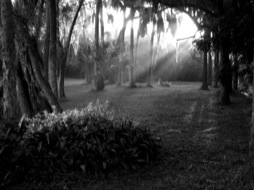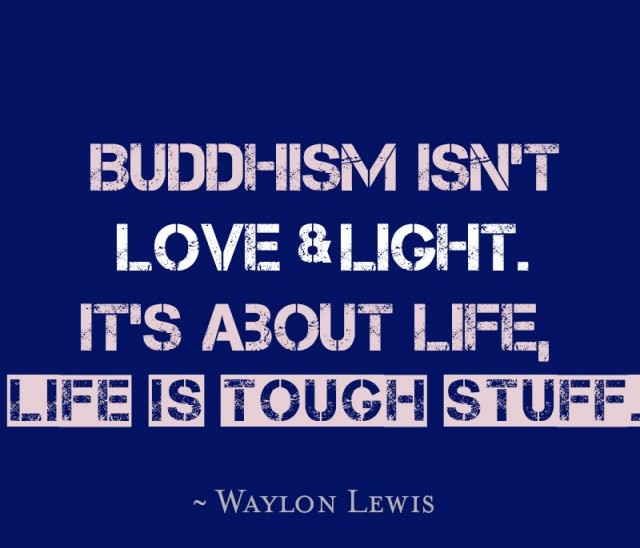According to Dave Evans and Bill Burnett, statistics from
Stanford’s Center on the Study of Adolescents show that only 20 percent of us have one identifiable passion that guides our life, which leaves 80 percent of us out of the conversation.
What this means is that instead of feeling inspired, most of us actually feel excluded.
So, what do the rest of us have? What do we identify with?
If not passion, then…it’s problems.
While only 2 out of 10 of us can name our passions, 10 out of 10 of us can tell you about our problems—it’s the most common of all denominators.
Year after year, resolutions after resolutions, no matter how many inspirational quotes or how many hours of TED talks, our abundance of problems never seem to actually diminish, much less dry out.
I’ve always resented the idea of being attached to a set of problems (which is, in and of itself, its own problem), because I think that’s an incredibly imprisoning mindset. Not to mention, Buddhist philosophy teaches us that
attachment creates suffering, so why should we attach ourselves to something so ugly in the first place?
So, I overcompensated, and fell into another common problem. I started to dismiss my problems because I thought that was one way to not give them power—by not recognizing their existence. I didn’t want to affirm my problems. I also avoided problems by choosing the path of least emotional pain, in the forms of lies and dissociation, all of which gave me access to a seemingly safer place to be.
Except our lies don’t actually work as walls or armor; they work as parasites.
The path of denial, dissociation, and avoidance can only carry us so far, and that was the marathon of my 20s. But running away doesn’t actually resolve anything. Some of us may never really need to confront our problems the way I have—but I have, at last, and this is what I have to say:
- Understanding ourselves is more than trying to figure out a nice answer to the question, “What’s your passion?”
- Understanding ourselves is more than goal-setting and creating vision boards after figuring out what it is we really want in life.
- Understanding ourselves starts with understanding our relationship with our problems. That means removing what looks good and calling out excuses where they loom.
- It takes real courage to confront our problems, as they are, as they belong to us, without assigning them to our perceived enemies.
- Distractions are not our true problems. They are how we deal (or not deal) with our problems.
- Dismissing our problems is a form of recklessness, irresponsibility, and self-sabotage.
- Once we own our problems, they stop owning us.
Because unlike our passions or dreams, which ebb and flow with fickle emotions and circumstances, our problems are the most faithful of all.
And at the root of all our problems, the most problematic of all, is: our dysfunctional relationship with them.
As a student of human behaviour, New York is the perfect lab to observe (and sometimes experience) dysfunctional relationships of every kind, to every degree.
There is neither moral compass, nor moral judgement—only plenty of company and plenty of acceptance, whichever poison we pick to deal with our problems. None of this brings us any closer to a clean or free life, because few of us have to truly confront what our problems are.
New Yorkers, like the rest of us (only with more ego and options), are all masters of avoidance, because a good part of us actually believe that we deserve to blossom, so we say “f*ck you” to our problems, and carry on.
Except the problems don’t actually go away, not even the imagined ones.
And then we develop new habits to deal with them…bad habits. Bad habits that we misidentify as our problems, because they are easier to see. Like every kind of addiction there is, every kind of disorder we develop, and every kind of dark emotion there is.
The problem isn’t with our relationship with any single substance, the problem is with ourselves, no one else, and nothing else. But until we realize that, we will continue to break every rule that we feel limits us, because being bad and being wrong somehow brings us comfort. We want to be sedated, because we don’t know what to do with discomfort, and pain is both familiar and disorienting.
We are misaligned at every level, but few of us recognize that.
It’s not our fault; it’s our conditioning.
From home, to school, to society, our general culture hasn’t truly prepared us on how to really identify what our problems are. Instead, our culture values higher ideals, and when it comes to problems, we shun them and treat them with blame, shame, and denial, none of which help us with the discernment of what it actually is that we are attacking, denouncing, and punishing.
Since our wiring and behaviour are direct responses to survival, all I can conclude is that we are simply taught the wrong things, and given the wrong tools to deal with our problems.
The problem is,
fighting, flighting, and freezing bring us no closer to solving any of our problems, or to identifying any of them. To further misalign ourselves, we solicit (often poorly given) advice from the wrong people—seeking relationship advice from work colleagues, and ranting our work problems to friends who are in totally different worlds—and instead of reaching any resolution, we gain only in misdirected and fiery charged energy.
If it takes roughly 10,000 hours to achieve mastery in any field, according to
Malcolm Gladwell, we need a whole lot more practice on identifying our true problems—and we’ve had about as many years as we have lived to
misidentify them.
And the lack of practice, when it comes to correctly identifying our problems, further distances us from where we need to be, because what we need to learn more of, we punish.
Where is the sense in that?
At the radio station where I have my day job, I recently started hosting a show called, “From One to Zero,” which is a one-hour weekly on air caller-engagement program that helps to take their problems “from one to zero.”
It’s my new favourite show to host, because there’s incredible satisfaction in problem squashing. The phone lines are always blowing up because of our 99 problems, the scarcity of them isn’t one. Taking in nonstop callers, the hour is sometimes gratifying, sometimes draining, and sometimes perplexing, but always quite enlightening (after a long exhale). Because I’ve recently developed a new curiosity with problems, this is fresh data to feast upon.
I’ve learned many things being the host of this show, including realizations I never expected I would have, such as, similar to how vocabulary is found to be linked to socioeconomic status, so too, are our problems—real, false, and imagined.
Our problems function as social indicators; our problems also expose our ignorance and blind spots. Sometimes, they expose our privileges.
The more I am exposed to others’ problems, the more curious I am about my own, and our common problems as humans, because we are more alike in our fallacies than we care to admit. Truly, we can’t even fail with distinction.
Being scammed seems to take the top bill as far as common problems go. But the problem isn’t that we’ve been scammed, the real problem is that we made ourselves vulnerable to the wrong people, and that we made poor investments in trust and resources. The problem isn’t so much that we feel duped and embarrassed, the problem is that we had different expectations of how these ventures should have turned out. The problem isn’t that we suffered loss, the problem is that we can’t take this experience beyond the pain it affects, and we don’t know what to do aside from being angry.
The problem is that we don’t know how we really feel.
The problem is no one bothers to ask us as deep as we need to be answered.
The problem is, when we feel pain, we don’t know how to communicate love, especially our desire of it.
We have a strange and most dysfuctional relationship with our problems—from identification to relation to resolution.
Gary John Bishop once said, during his course on “Unf*ck your relationships,” that we cannot resolve a problem that is beyond ourselves. If the problem is not within us, in other words, if we do not own the problem, then we also have no ownership over solving the very problems that plague us.
We cannot solve a problem we are denying, we cannot solve a problem we are not willing to have, and we cannot solve our problems if we don’t know what they truly are.
So the first step in re-identifying our problems is to take inventory of what they are. Once we have our lists, this is the labyrinth in which we will find the answers we seek.
In the movie, “Beautiful Boy,” the beautiful boy was asked, in a rehab center, what his problem was, and he identified drugs and alcohol. The response that followed is part of what inspired this piece, and that is, “That’s not your problem; that’s how you deal with your problems.”
Just like how we cannot heal a misdiagnosed illness, we cannot solve a misidentified problem.
To acknowledge a problem, the way it truly is, is not only painful, but also difficult. It necessitates not only self-knowledge, but also a deep degree of self-love, honesty, and self-compassion. It’s a terrifying practice of radical acceptance, but it’s only terrifying at first. Of course, we cannot go far without curiosity, either.
Reframing is a hot concept right now in the world of self-help, and I urge everyone to try it.
It’s paradigm-shifting radical magic.
However, no amount of reframing the misidentified problem can bring us closer toward a resolution.
We cannot reframe something that isn’t ours; we cannot reframe something we say does not exist; we cannot reframe something we are simply not willing to have in our space—and much like curing a sickness we didn’t have in the first place, we cannot solve anything by reframing a problem if it’s not the actual problem.
While the fortunate 20 percent of us can identify our passions, it is uncertain how much of these identified passions truly drive a successful, fulfilling life. Almost daily, stories are leaked about troubled geniuses, and the fall of so many we revered as icons.
What is certain, it seems, is that our lives tend to be led more by chaos and problems, than anything else that is more lofty.
So isn’t it time that we figured out what our real problems are, instead of what our passions are?
Problems are ugly, and we become just like them, the more we don’t see them for what they are. The most sophisticated versions of ourselves descend into a state of madness when we are confronted with something that triggers our pain—because as much as we mentally deny it, our bodies still respond to it. Energy doesn’t lie, and we are made to resonate with matching pictures.
Our problems show up because something within ourselves has manifested a matching energy. Our brain takes up around only three percent of our body weight but 25 percent of our energy. What we spend our energy on determines the quality of our lives, and our reptilian brains tend to be more consumed and tainted with problems, than they are elevated by our dreams.
As ugly as this sounds, most of us are more committed to our problems than we are to our dreams, and that manifests in life in a million different permutations of pain.
A life coach once said that our life plans get destroyed at the first contact with reality.
The same goes with our imagined problems—because all imagined worlds, all fiction, will fail at the first contact with reality. Reality always wins.
That’s why so many of us have denial problems.
But the cure is within reach. We don’t need more imagination, we need more confrontation. The key is finding alignment within our selves, and within the world we live in. We cannot just conjure up a world that is more comforting—as seemingly safe as that feels. Because for most of us, the bill always comes due.
We all arrive at this point, in our own time. Cajoling doesn’t work, shaming doesn’t work, blaming doesn’t work, and attacking only makes the process longer. I hope you arrive at your truths sooner rather than later.
~



